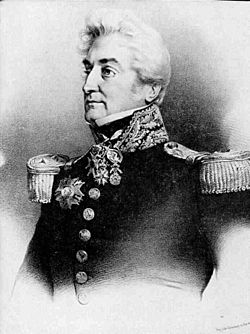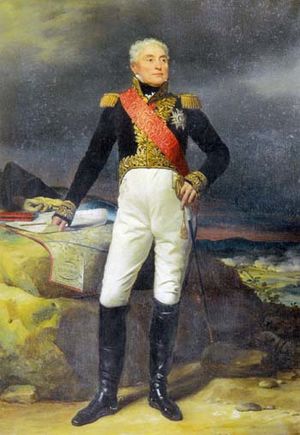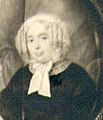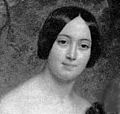Joseph Lagrange (soldier) facts for kids
Quick facts for kids
Joseph Lagrange
|
|
|---|---|

General Count Joseph Lagrange.
|
|
| Born | 10 January 1763 Sempesserre, France |
| Died | 16 January 1836 (aged 73) Paris, France |
| Allegiance | |
| Service/ |
Infantry |
| Years of service | 1791–1815 |
| Rank | Général de Division |
| Battles/wars | French Revolutionary Wars Napoleonic Wars |
| Awards | Count of the Empire 1810 |
| Other work | Inspector General of Gendarmerie |
Joseph Lagrange (born January 10, 1763 – died January 16, 1836) was a brave French soldier. He started as a regular soldier and worked his way up to become a very important general during the French Revolutionary Wars and the Napoleonic Wars. He reached the highest military rank, called a General of Division. His name is even carved on the famous Arc de Triomphe in Paris! Later in his life, he also became a politician in the Gers region of France. In the city of Auch, you can find his portrait in the town museum. A police station (gendarmerie barracks) there was named after him in 2002.
Contents
Early Life and Military Career
Joseph Lagrange was born on January 10, 1763. His father, Armand Lagrange, was a merchant. Joseph first became the mayor of Lectoure in 1791.
Joining the Army
Three years later, in 1794, he joined the army. He started as a captain in the 2nd Gers Volunteer Battalion. He fought in Carinthia and Tyrol during the Italian campaigns of 1796 and 1797.
Service in Egypt
Joseph Lagrange quickly moved up in the army ranks. Napoleon Bonaparte himself chose Lagrange to join the French invasion of Egypt. He fought in Egypt and Syria. On July 14, 1798, he became a brigadier general. He led the first group of soldiers into Cairo. He also showed great bravery during the siege of El Arish, the siege of Acre, and the Battle of Heliopolis.
Return to France
When he returned from Egypt, he was made inspector general of the gendarmerie (a type of military police). He also became a général de division, which is a very high rank. On September 23, 1800, he was put in charge of the 14th Military Division. He received important awards, becoming a knight of the Légion d'honneur in 1803 and a grand officer in 1804.
Napoleonic Wars Campaigns
In 1805, General Lagrange was given command of an expedition. His mission was to fight against the British colonies in the Antilles. He landed at Roseau and successfully captured ships, soldiers, weapons, and supplies in the port. He then destroyed the enemy's forts and supply areas.
Campaigns in Europe
Lagrange returned to Europe in early 1806. He was put in charge of a division sent to Holland. He helped the French army succeed in the 1806 Prussian campaign. He fought against the elector of Hesse-Cassel under maréchal Mortier.
He also helped create the Kingdom of Westphalia. He became the minister of war and chief of staff for its first king, Jérôme Bonaparte.
Fighting in Spain and Germany
In 1808, Lagrange was called to fight in the Peninsular War in Spain. He took part in the attack on Lascanti on November 18. He also helped in the victory at the battle of Tudela, where the French caused heavy losses to the enemy.
In 1809, he was sent to Germany. There, he commanded soldiers from Charles I, Grand Duke of Baden's army. On April 26, 1810, he was given the title of a count of the empire.
Russian and German Campaigns
At the start of the French invasion of Russia in 1812, he became governor of Haute-Souabe. He also commanded a division in the 9th Army Corps. In 1813, he joined maréchal Marmont's corps. He fought in several battles, including the battle of Dresden and the Battle of Leipzig.
Final Battles and Injury
Lagrange also fought bravely in the French campaign of 1814. He was especially noted for his actions in the battle of Lesmont on February 2, 1814. He also fought in the battle of Champaubert on February 10, 1814, where he was badly wounded in the head.
Political Career
When Napoleon first lost power, Joseph Lagrange retired to Gisors. He did not return to the army during the Hundred Days (when Napoleon briefly returned to power).
Later Political Roles
In 1817, he became the president of Gers' electoral college. On September 20, he was elected as a deputy (a representative) for that region. He was part of the Royalist majority in the government. In 1818, he was again made inspector general of the gendarmerie. On May 1, 1821, he received the highest rank of the Légion d'honneur, called Grand Cross.
He did not take part in the July Revolution of 1830. However, the new government under Louis-Philippe I appointed him to the Chamber of Peers on November 9, 1831. This was a high legislative body. He was allowed to retire on June 11, 1832, with the rank of lieutenant general. He remained a member of the upper chamber until his death.
Family Life
On November 6, 1802, Joseph Lagrange married Marie de Talhouët (1786–1849) in Paris. She was the oldest daughter of Louis Céleste de Talhouët-Bonamour and Élisabeth Baude de La Vieuville. They had five children:
- Napoléon Joseph (1804–1812)
- Caroline Élisabeth (1806–1870), who married Louis Alix de Nompère de Champagny in 1824.
- Mathilde Louise (1809–1873), who married Napoléon Bessières in 1826.
- Emma (1810–1876), who married Charles Ferron de La Ferronays.
- Frédéric (1815–1883), who married Émilie de Riquet de Caraman in 1850.
Images for kids
-
Caroline Elisabeth Lagrange (1806-1870), wife of the 2nd duke of Cadore, Franz Xaver Winterhalter, 1821
-
Caroline Elisabeth Lagrange, Jean-Baptiste Carpeaux, c 1861
-
Emma Lagrange (1810-1876), Franz Xaver Winterhalter, 1821
-
Frederic Lagrange (1815-1883), 2nd count of Lagrange, National Horseracing Museum, Newmarket (Suffolk)
See also
 In Spanish: Joseph Lagrange para niños
In Spanish: Joseph Lagrange para niños







